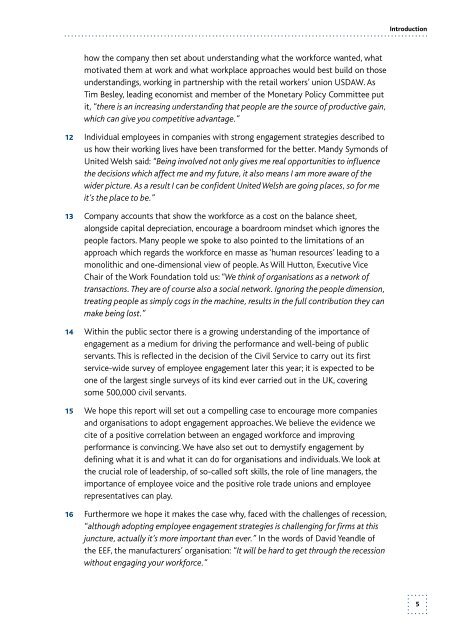3ytgeaf
3ytgeaf
3ytgeaf
Create successful ePaper yourself
Turn your PDF publications into a flip-book with our unique Google optimized e-Paper software.
Introduction<br />
how the company then set about understanding what the workforce wanted, what<br />
motivated them at work and what workplace approaches would best build on those<br />
understandings, working in partnership with the retail workers’ union USDAW. As<br />
Tim Besley, leading economist and member of the Monetary Policy Committee put<br />
it, “there is an increasing understanding that people are the source of productive gain,<br />
which can give you competitive advantage.”<br />
12 Individual employees in companies with strong engagement strategies described to<br />
us how their working lives have been transformed for the better. Mandy Symonds of<br />
United Welsh said: “Being involved not only gives me real opportunities to influence<br />
the decisions which affect me and my future, it also means I am more aware of the<br />
wider picture. As a result I can be confident United Welsh are going places, so for me<br />
it’s the place to be.”<br />
13 Company accounts that show the workforce as a cost on the balance sheet,<br />
alongside capital depreciation, encourage a boardroom mindset which ignores the<br />
people factors. Many people we spoke to also pointed to the limitations of an<br />
approach which regards the workforce en masse as ‘human resources’ leading to a<br />
monolithic and one-dimensional view of people. As Will Hutton, Executive Vice<br />
Chair of the Work Foundation told us: “We think of organisations as a network of<br />
transactions. They are of course also a social network. Ignoring the people dimension,<br />
treating people as simply cogs in the machine, results in the full contribution they can<br />
make being lost.”<br />
14 Within the public sector there is a growing understanding of the importance of<br />
engagement as a medium for driving the performance and well-being of public<br />
servants. This is reflected in the decision of the Civil Service to carry out its first<br />
service-wide survey of employee engagement later this year; it is expected to be<br />
one of the largest single surveys of its kind ever carried out in the UK, covering<br />
some 500,000 civil servants.<br />
15 We hope this report will set out a compelling case to encourage more companies<br />
and organisations to adopt engagement approaches. We believe the evidence we<br />
cite of a positive correlation between an engaged workforce and improving<br />
performance is convincing. We have also set out to demystify engagement by<br />
defining what it is and what it can do for organisations and individuals. We look at<br />
the crucial role of leadership, of so-called soft skills, the role of line managers, the<br />
importance of employee voice and the positive role trade unions and employee<br />
representatives can play.<br />
16 Furthermore we hope it makes the case why, faced with the challenges of recession,<br />
“although adopting employee engagement strategies is challenging for firms at this<br />
juncture, actually it’s more important than ever.” In the words of David Yeandle of<br />
the EEF, the manufacturers’ organisation: “It will be hard to get through the recession<br />
without engaging your workforce.”<br />
5


